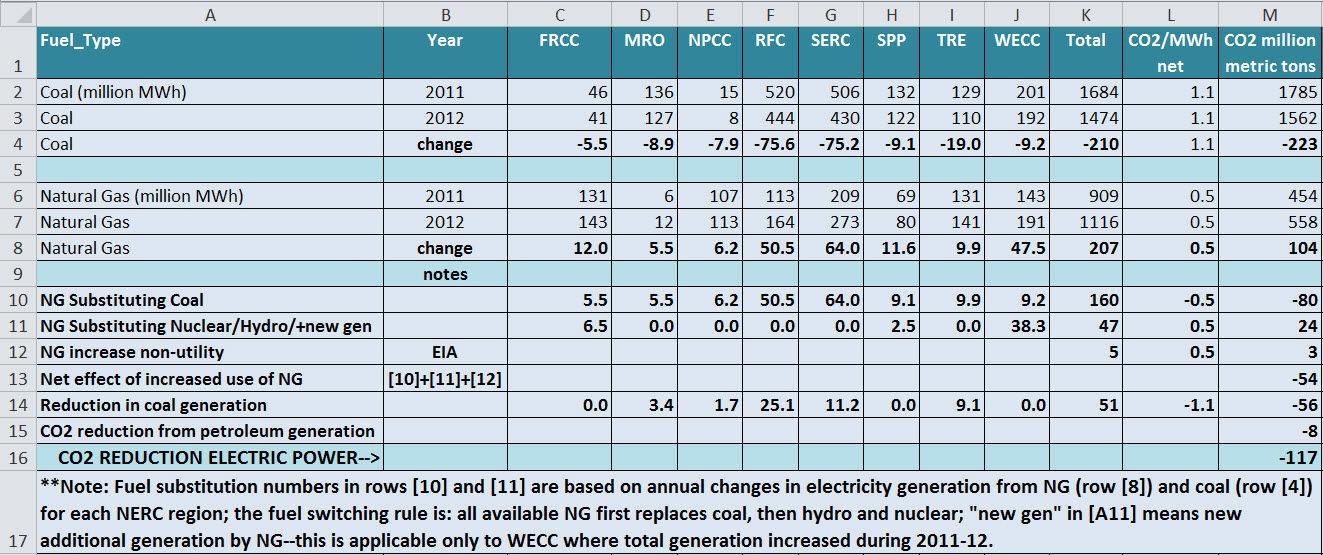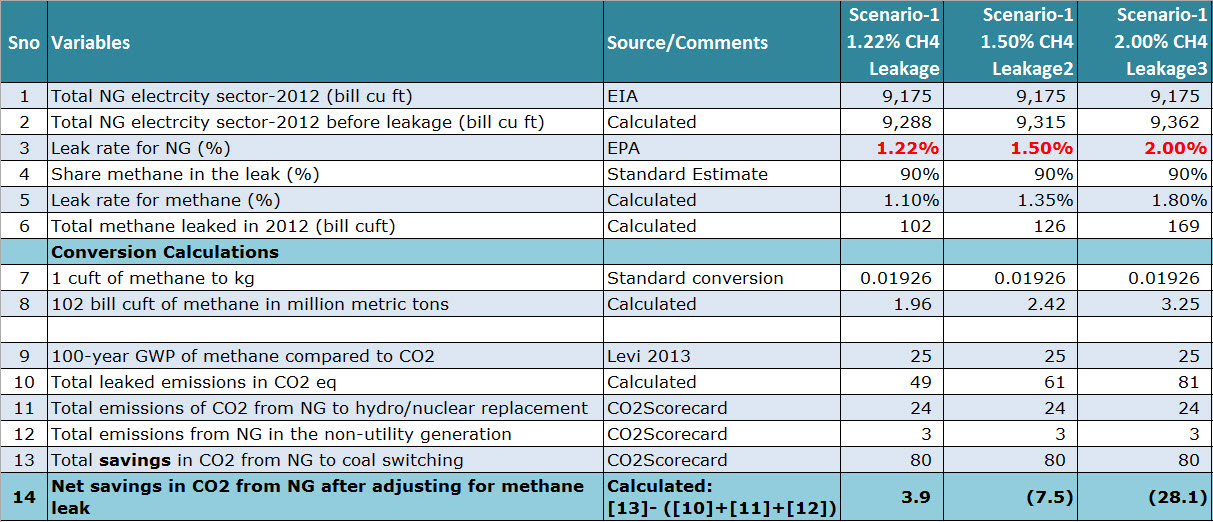Shale Gas: Killing Coal without Cutting CO2
Written by:
Shakeb Afsah and
Kendyl Salcito • Dec 02, 2013
Topic: Natural Gas
Summary
It is well known that natural gas generates only half the CO2 of coal for every MWh of electricity generation. However, there are two offsets that nibble away at these CO2 savings. The first is the component of natural gas generation that displaces nuclear and renewable sources of energy that have no emissions. The second is methane leaks. Using the US electricity sector data for 2012, we show that even at a low leakage rate of 1.22% (USEPA’s estimate for power plants comparison) the two offsets combined were sufficient to almost erode the entire annual savings in CO2 from coal-to-gas fuel switching.
We discuss policy and regulatory implications of our findings.
Corresponding author: Kendyl.Salcito@CO2Scorecard.org
We are thankful to Malcolm Baldwin, Jonathan Camuzeaux and David Wheeler for their comments on this research note. All the views and opinions expressed in this note should be attributed only to the authors and the CO2 Scorecard Group. This research note is supported solely by the efforts and resources of The CO2Scorecard Group based in Bethesda MD, US.
Full Report
CO2 Scorecard has been conducting detailed analysis on the environmental implications of the newfound popularity of natural gas. In May 2013 we demonstrated that only 25% of US emissions reductions were attributable to the switch from coal to natural gas in 2012. Energy efficiency and conservation contributed most to the annual decline. Last month the US Energy Information Agency (EIA) affirmed our main findings in their analysis of the 2012 CO2 trends.
In our previous analysis, we showed that when there is an increase in electricity generation from natural gas, it does not necessarily substitute for coal—some replaces zero-carbon sources like hydro and nuclear. In such cases, every MWh of electricity from natural gas adds about half a ton of CO2. As reported by Bloomberg, this effect was most palpable in 2012 for the state of California, and it was present in other NERC regions too.
But our analysis did not go far enough. Some natural gas leaks into our atmosphere long before it reaches the power plants where it is combusted to generate electricity. This un-burnt natural gas is mostly methane (CH4), a greenhouse gas that is nearly twenty five times more lethal than CO2.
The amount of methane leakage needs to be quite small to protect the benefits of natural gas over coal, which (ignoring offsets) represent about a half ton of CO2 for every MWh that switches from coal to natural gas. If the combined total emissions from the effects of leakage and replacement of renewables/nuclear are large, they could erode the entire advantage that natural gas has over coal. This is an empirical question worth millions of tons of CO2.
Empirical Methodology
With this in mind, we re-crunch the numbers for 2012 to get a more realistic assessment of the contributions of natural gas in cutting CO2 emissions in the electricity sector.
Our analysis has three parts. First, we quantify the share of gas-powered electricity that replaced coal in 2012. Next, we analyze the share of gas that substituted zero-carbon sources including hydro, nuclear, wind and solar. Finally, we estimate the quantity of methane that leaked on its way from production wells to power plants where it was finally combusted to generate electricity in 2012.
For the first two components, we rely on our previous research note titled “Demand Reduction Slashes US CO2 Emissions in 2012”. In this analysis, we applied the electricity generation data for each regional grid in the US and calculated that natural gas replaced 160 million MWh of electricity that was previously generated from coal in 2011. At the rate of around half a ton of CO2 savings per MWh, this fuel switching saved around 80 million tons. For the second part of the analysis, our calculations show that 47 million MWh of electricity from natural gas replaced hydro and nuclear—the zero-carbon sources. As a result, gas added around 24 million tons of CO2 (each MWh from gas added half a ton of CO2). Around 5 million MWh of electricity in the non-utility sector came from natural gas. This is a small component and added around 3 million tons of CO2.
As a result of these offsets, the total savings in CO2 from the increased use of natural gas in the electricity sector shrinks to 54 million tons (80–24 –3=54 tons). These calculations are explained in the earlier research note and shown here as Exhibit-1 / row #13/ column M.
Exhibit-1

Adjustment for Methane Leak
The 54 million tons of CO2 saved by the switch to natural gas in 2012 was itself partially offset, however. Methane leaks during the delivery of natural gas from well-heads and processing plants to city gate stations where it is picked up by power plants. Given methane’s potent effects on the environment, it needs to be considered in calculations of natural gas’ climate benefits.
Exhibit-2

According to the EIA data, the electricity power sector consumed 9,137 billion cubic feet of natural gas in 2012—the volume of gas that was finally delivered to power plants net of all leakage. The USEPA set the leakage rate applicable for power plants (production wells to city gate) at 1.22%--though the overall average is around 1.5%. Making a slight adjustment for the shift from gross power produced to net leakage, the quantity of natural gas that leaked into our atmosphere during the transmission process from production wells to power plants comes to around 113 billion cubic feet based on USEPA leakage rates. However, not all natural gas is methane; for our calculations, we assume that methane accounts for 90% of the leakage. With this adjustment, the total volume of leaked methane in the electricity sector comes to around 102 billion cubic feet or in terms of weight around 2.0 million metric tons of methane (Exhibit-2).
 The final step requires a conversion of leaked methane into its CO2 equivalent using the most acceptable global warming potential (GWP). For this, we apply a 100-year GWP of 25 (Levi 2013). As a result, the total leaked methane in terms of CO2 equivalent comes to 50 million—an amount that erodes almost the entire advantage that natural gas had over coal in the electricity generation process in 2012 (Exhibit-3). Many organizations estimate that a leakage rate of 2-3% cancels out all of natural gas’s CO2 emissions advantage over coal. However, using the actual electricity sector data for 2012, a much lower leakage rate is a deal-breaker for CO2 emission reductions.
The final step requires a conversion of leaked methane into its CO2 equivalent using the most acceptable global warming potential (GWP). For this, we apply a 100-year GWP of 25 (Levi 2013). As a result, the total leaked methane in terms of CO2 equivalent comes to 50 million—an amount that erodes almost the entire advantage that natural gas had over coal in the electricity generation process in 2012 (Exhibit-3). Many organizations estimate that a leakage rate of 2-3% cancels out all of natural gas’s CO2 emissions advantage over coal. However, using the actual electricity sector data for 2012, a much lower leakage rate is a deal-breaker for CO2 emission reductions.
A Second Scenario Analysis
As shown in Exhibit-2, if we increase the methane leakage rate to 1.5% for the 2012 data, natural gas turns into a net CO2 emitter in the electricity sector, adding around 7 million tons of CO2 equivalent. If the leakage rate is further increased to 2%, natural gas ends up adding 27 million tons to the 2012 CO2 emissions in the electricity sector—that’s equivalent to adding a large coal power plant. Clearly, the tolerable margin for methane leak that would justify natural gas as a CO2 saving fuel is slim.
Climate Implications
By replacing 160 million MWh of coal electricity with natural gas, the US slashed nearly 80 million tons of CO2 emissions in 2012. By all measures this is a significant reduction in CO2 emissions for a single year. That is until you factor in two offsets—methane leakage, and the replacement of hydro and nuclear by gas. These two offsets together wipe out the entire CO2 reduction from coal-to-gas fuel switching; methane leakage accounts for more than two thirds of that offset.
To properly account for CO2 reductions from coal-to-gas fuel switching, it is important to include all offsets as analyzed in this note. That leads to a far more stringent cut-off point for methane leak before fuel switching from coal-to-gas actually saves CO2.
Policy Implications
We see two reasonable policy responses to address these findings. First, policies that would ensure that a much larger share of coal electricity is replaced by renewables are needed. Each MWh of such replacement saves one ton of CO2—twice the reduction compared to natural gas. Such a scenario would make some replacement of hydro and nuclear by gas more tolerable. This can be best achieved by putting a price on carbon.
Second, we need regulations that would make it mandatory for production and processing sites to periodically self-monitor and report methane leaks to regulators. Such self-monitored data should be periodically verified through regulatory inspections to ensure that on-site monitoring is properly managed to minimize methane leaks.
In light of how small leakage rates must be to protect the benefits of natural gas over coal, data needs to be accurate and precise. At present, convincing data on methane leaks is elusive. In one case, in the span of one month, the University of Texas found low levels of methane leakage and the National Academy of Sciences found damagingly high levels of methane leaks. This back-and-forth creates confusion in the public sphere and in the policy arena. The most reasonable way forward is to institute regulatory requirements for measurements and reporting of methane leaks by drillers. Colorado has made the move—other states and the USEPA should follow. Such regulatory action is increasingly recognized as necessary, supported by a growing body of scientific literature.
Natural gas can remain a viable energy source for climate management only if we put a price on carbon and minimize methane leaks through monitoring regulations.
Supplemental Note
Natural gas may not have a clear CO2 advantage over coal, but gas may still be preferable to coal because it releases comparatively little SOx, NOx, and no toxicants like mercury. Its production also does not entail the damaging land and stream valley impacts of strip mining and, in particular, mountain top removal. However, shale gas from hydraulic fracturing may have hydrogeological impacts that could offset the benefits of its reduced impacts on air quality.
Background Reading
http://www.nytimes.com/2013/07/29/opinion/gangplank-to-a-warm-future.html?_r=2&
http://www.nytimes.com/2013/11/19/opinion/nocera-frackings-achilles-heel.html?hp&rref=opinion
http://thebreakthrough.org/index.php/programs/energy-and-climate/methane-leakage-not-a-deal-breaker-for-natural-gas/
http://www.nytimes.com/2012/02/28/opinion/nocera-how-to-frack-responsibly.html
http://online.wsj.com/news/articles/SB10001424052702303492504579111360245276476
http://www.nytimes.com/2013/10/05/opinion/a-fracking-rorschach-test.html
http://www.eeb.cornell.edu/howarth/Howarth%20et%20al%20%202011.pdf
http://www.nytimes.com/2011/04/16/opinion/16nocera.html
http://dotearth.blogs.nytimes.com/2013/09/16/encouraging-results-in-first-nationwide-look-at-gas-leaks-from-fracking-boom/
http://pubs.acs.org/doi/abs/10.1021/es203750k
http://www.desmogblog.com/2013/09/16/frackademia-people-money-behind-edf-fracking-methane-emissions-study
http://bigstory.ap.org/article/study-methane-leaks-gas-drilling-not-huge
http://blogs.cfr.org/levi/2013/05/08/another-way-to-think-about-short-lived-greenhouse-gases/